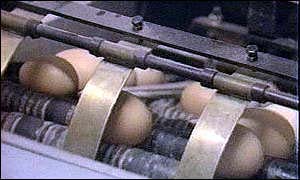|
27th January 2003
BBC NEWS
The additive makes egg yolks appear more yellow
The European Union has limited permitted levels
of a food additive given to salmon and poultry,
which may damage the eye.
The chemical, canthaxanthin, is added to feed. It makes salmon appear more reddish, and chicken skin and egg yolks appear more yellow, but research has suggested that a build up of pigments can damage the retina.
The level of the chemical allowed in salmon feed is to be cut by over two thirds.
“Eating products with low levels of canthaxanthin is not something that people need to be worried about,” said a Food Standards Agency spokeswoman.
Limits will be even stricter in the feed for laying hens.
Officials say the restrictions will not have any impact on the quality of farmed salmon or supermarket eggs.
Assessments
The European Commission said levels of the chemical should be reduced from a maximum of 80mg per kilogram to 25mg per kilogram of feed for fish and poultry, and 8mg per kilogram for laying hens.
All EU members will have to enforce new regulations by the end of the year.
Commissioner David Byrne said: "Scientific assessments have shown that a high intake of canthaxanthins produces an accumulation of pigments in the retina, affecting the sight,.
"The use of this feed additive is purely cosmetic."
Extreme consumption
A spokeswoman for the UK's Food Standards Agency (FSA) told BBC News Online: "What the EU has been looking at is the very extreme consumption of products containing canthaxanthin.
"But it's something that's related to long-term exposure rather than acute.
"Eating products with low levels of canthaxanthin is not something that people need to be worried about."
She said the FSA wanted to see levels of canthaxanthin in fish flesh, rather than in the feed measured, and labelling of products so consumers could see how much canthaxanthin they contain.
Top
|
